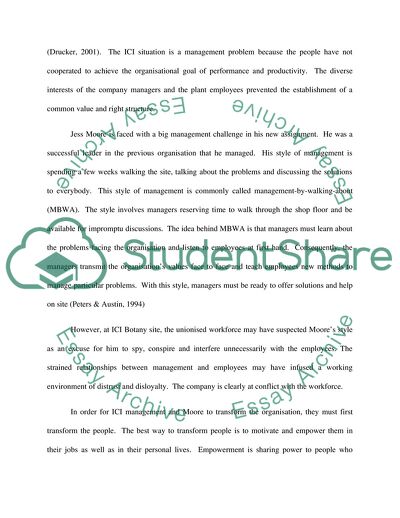
- Home
- Free Samples
- Premium Essays
- Editing Services
- Extra Tools
- Essay Writing Help
- About Us
- Studentshare
- Subjects
- Miscellaneous
- Case study (Leading in Organisations)
Case study (Leading in Organisations) - Essay Example

- Subject: Miscellaneous
- Type: Essay
- Level: Masters
- Pages: 4 (1000 words)
- Downloads: 0
- Author: xhowell
Extract of sample "Case study (Leading in Organisations)"
A unionised workforce can create a negative impact on the organisation such as lower productivity, reduced profit and decreased competitive advantage (Clarke, 1984, p. 893). However, an effective and empowered union can assist and facilitate the enhancement of a company’s performance. Presence of a union can have several advantages. Unions can reduce the turnover of experienced workers, increase employee morale and enhance the quality of work (Freeman & Medoff, 1984). It is up to the management to smarten up and take advantage of the union’s presence to create better communication channels and improved work processes (Flood & Turner, 1993).
It is the task of an effective management to make people work together to achieve a common goal, to establish a common value and to create the right structure in order to perform (Drucker, 2001). The ICI situation is a management problem because the people have not cooperated to achieve the organisational goal of performance and productivity. The diverse interests of the company managers and the plant employees prevented the establishment of a common value and right structure. Jess Moore is faced with a big management challenge in his new assignment.
He was a successful leader in the previous organisation that he managed. His style of management is spending a few weeks walking the site, talking about the problems and discussing the solutions to everybody. This style of management is commonly called management-by-walking-about (MBWA). The style involves managers reserving time to walk through the shop floor and be available for impromptu discussions. The idea behind MBWA is that managers must learn about the problems facing the organisation and listen to employees at first hand.
Consequently, the managers transmit the organisation’s values face to face and teach employees new methods to manage
...Download file to see next pages Read MoreCHECK THESE SAMPLES OF Case study (Leading in Organisations)
Sociological Paradigms and Organisational Analysis
Reading Log and Case Study
Information, Knowledge and Learning Organisation
Management, People and Organisations - Managing the United Kingdom National Health Service
Open Systems Approach to Organisations
Downsizing and Expansion within the UAE Based Organisations to Maintain Market Stability
The Nonprofit Organization as Black CAP
Operations of a Community-Based Housing Organization

- TERMS & CONDITIONS
- PRIVACY POLICY
- COOKIES POLICY